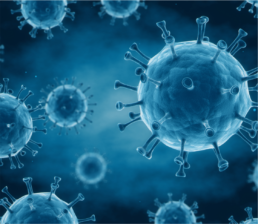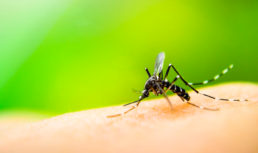Class at Elon University Sets Out to Teach Locals About Contamination in their Waterways
Class at Elon University Sets Out to Teach Locals About Contamination in their Waterways
Because PFAS are such a new research topic, a lot of people aren't aware that it's even a problem! How can you be part of a solution if you don't know there's something to be fixed?
Some towns in North Carolina have been contaminated for so long, that locals no longer think anything of it. On Elon News Network's website, Cailey Cetani has an article detailing how one person hopes to help change this. In order to educate locals around the Haw River about the dangers chemical pollution can have, an environmental science professor at Elon University, Kelsey Bitting, and her class, have partnered with the Clean Haw River Project. "As a part of her ENS 111, Introduction to Environmental Science class, Bitting is pairing up with The Clean Haw River Project to engage students by creating visual presentations — such as greeting graphics, articles and research presentations — that will immediately go toward helping The Clean Haw River Project’s cause." Bitting's goal is to not only encourage and motivate community members to help solve the water crisis in their area, but also engage students in real world problems.
We admire Kelsey Bitting for her efforts in educating people and trying to raise awareness for what is a very widespread issue.
Read more about what her class is doing here.
What You Need to Know about GAC Filters
What You Need to Know about GAC Filters
At Encore Earth, our focus is eliminating PFAS chemicals from all water, not just the drinking water. But we do know it has to start somewhere, and we want to support those who are working hard to stop it from getting to your kitchen sink. It’s important for everyone to remember that this is only the first step in taking on a much bigger challenge.
How are Treatment Plants Removing PFAS?
Currently, water and wastewater plants have a treatment for removing nutrients like phosphates and nitrates from the water, and for getting rid of contaminants such as pharmaceuticals and heavy metals. However, when it comes to removing PFAS compounds, also knowns as “forever chemicals,” the water must be treated with very specific solutions. Removing PFAS compounds from water is a new regulation, and the standards and allowed levels are still being determined by the EPA. Anyone who has read the news lately, however, knows that PFAS chemicals can cause many serious human and environmental problems.
Granular Activated Carbon
Currently, one of the best options for wastewater treatment plants is to filter PFAS out of the water using activated carbon. Activated carbon absorbs organic and synthetic compounds, like PFAS, as it passes through the filters in the plant. Activated carbon is an effective adsorbent because it's a very porous material and provides a large surface area that contaminants get absorbed into. The most common type is called a Granular Activated Filter (GAC). GAC filters are made from organic material with high carbon contents like wood and coal, and are used in granular (or powdered) form. An example would be black charcoal, in the sense that it has become so popular for removing toxins. GAC filtration has been shown to effectively remove PFAS from drinking water and works when it is used in a flow-through filter mode after particulates have been removed. However, those particulates need to go somewhere safe, because after absorbing the PFAS, they too have PFAS in them.
How Much PFAS Do They Remove?
The EPA has said that GAC filters can be 100% effective “for a period of time” but that seems to depend on a variety of factors. These factors include the depth of the bed of carbon, flow rate of the water, which PFAS need to be removed, water temperature, etc., which makes this solution very complicated. Granular activated carbon filters are also know to work well on certain, long-chain PFAS chemicals (ie. PFOA and PFOS) , but aren’t as good at capturing the short-chained (and sometimes, more recently developed) compounds such as PFBS and PFBA. This is due to lower absorbency rates.
How Long Do They Work?
Like all filters, GAC filters get clogged up and need to be changed or cleaned. The benefit of GAC filters is that they can be reused. Because PFAS compounds have to be heated up to an extreme temperature to be destroyed, the filters need to go through a process of thermal regeneration in order to be used repeatedly. Unfortunately, they begin to lose effectiveness over time, and slowly allow more and more PFAS to get into the drinking water. This means in addition to cleaning the filters, they’ll need to be continuously replaced, which can be very costly. Furthermore, the regeneration process is very energy intensive, and is not necessarily environmentally-friendly.
What Happens to the “Leftovers?”
A major concern that we focus on at Encore Earth is this questions: what happens to the filters, the waste that’s rejected from the filters, and that “brine” or sludge that’s sent away from the treatment plant once the drinking water part passes through? The reality is that all of the waste that now has concentrated PFAS in it ends up being sent right back to the land or returned to the plant at returned activated sludge. For the sludge that is sent to landfills, this concentrated hazardous waste sits in the heap until eventually it begins to leach out and is sent right back to the water treatment plant to re-contaminate the water.
What is not sent to landfills is used as fertilizer or injected as liquid into agricultural land, where the PFAS compounds travel up the plants and transfer to crops that are sold in stores or fed to livestock.Because PFAS compounds are not biodegradable, they then contaminate consumers who drink milk or eat vegetables or other produce from locations where sludge was spread on the land. Sometimes, if a treatment plant is near an ocean, the PFAS contanimated brine is actually sent directly into the ocean, using “dilution” as the treatment method. This is one reason why polar bears in the Artic have been tested and found to have PFAS compounds in their bodies.
How Can We Stop This PFAS Spread?
Even though our drinking water is beginning to be treatment for PFAS chemicals, there is still so much work that needs to be done to stop the cycle of these harmful chemicals. When it comes to waste treatment, we need to work together to stop PFAS contaminated sludge from being sent to landfills or to agricultural land so that it no longer contaminates our food, environment and our bodies.
Using our patent-pending process, Encore Flow, we’re stopping the endless PFAS cycle with our energy efficient, carbon negative, environmentally friendly solution. Many water treatment plants in the US are working hard to increase filtration against PFAS chemicals, but there’s a missing piece, and that’s where we work. The Encore Flow process ensures that the filters, backwash and all of the concentrated PFAS brine and sludge that’s leftover is destroyed forever. And our solution works in wastewater treatment plants without the need for specialized filtration or expensive equipment. Our Encore Flow process stops PFAS compounds from returning back into our ecosystem and makes the planet a healthy environment once again.
How Can You Help?
If you or someone you know is working hard to help keep your community safe from the PFAS compounds that plague our world, reach out to us at Encore Earth, and let us know how we can connect and help them solve this problem with our solution! We’re talking with many people in the government, cities, states, and local wastewater treatment plants and advocates to solve this problem today and return balance to our planet.
Five Things You Need to Know About PFAS
Five Things You Need to Know About PFAS
And Why We Need to Stop Them from Destroying our Earth
What are PFAS?
Since the 1940s, a group of man-made chemicals called per- and polyfluoroalkyl substances, generally referred to as PFAS, has been manufactured and used in a variety of industries around the world. They are often called “forever chemicals” because they never break down, they just build up over time. Once introduced to the environment or human body, they stay there, and have been proven to cause health risks to our bodies and ecosystems.
According to the EPA, there are a variety of ways that people can be exposed to these chemicals. In humans, PFAS exposure can come from ingesting contaminated food or water or from prolonged use of a product with PFAS in it (I’ll get into that a bit more in my next video!) However, while there are many ways humans and animals are exposed, contaminated water is the reason PFAS have spread and are now found worldwide.
What Health Effects do they Cause?
There is extensive evidence of the adverse health effects PFAS exposure can cause in humans. So many studies have confirmed that these “forever chemicals” can cause things like infertility (in men and women), increased risk of cancers, higher cholesterol, and decreased vaccine response in children, among other health conditions.
Where are they?
Because “forever chemicals” are all human made, it’s easy to believe that their reach would only extend to areas where humans frequent. Unfortunately, that’s not the case. Even some of the most remote locations on the planet aren’t safe from PFAS contamination, as these chemicals have been discovered on Mt. Everest and all over the planet.
How do we Get Rid of them?
There is a reason they’re called “forever chemicals”. PFAS are known as a bioaccumulater, which means they accumulate over time in an organism, making them extremely hard to get rid of. What makes it worse, is that it’s extremely hard to even test for PFAS. This is because even though they’ve been around for 80 years, these chemicals are only just beginning to be part of the conversation. And, ironically, PFAS are often found in bottles and containers, making it even harder to know exactly what's in that testing tube.
Luckily, there are ways to stop the spread of PFAS once they’ve been tested for. They can be filtered out of drinking water. It’s expensive and time consuming, but it’s a good start. And at Encore Earth, we’re working with filtration companies to help make this process even better. It’s also important to stop using PFAS chemicals in everyday products. Seems like something so simple, but there need to better alternatives first. In order to actually get rid of PFAS, they need to be heated up and incinerated. At Encore Earth, our process collects the PFAS and destroys them, entirely, in a carbon negative process. We need more people to do this as we’re basically fighting a global invisible army.
How Big of a Deal is this? Are People Talking about it?
On Friday, March 26th, news reports announced the following:
- 2 cities in the US declared the need for bottled water to be used instead of tap water due to finally testing the water and finding it positive for PFAS, with half of the places tested at levels about what the stated considered safe
- Public health announcements came out about preservative jars having PFAS in them, and also biodegradable drinking straws having PFAS in them
- The EPA announced that they are again seeking more comments from the public on PFAS removal
- The DOD testified again about efforts to mitigate and clean up PFAS
- A city in Massachusetts won a small grant to start treating PFAS in their drinking water
- And two lawsuits were settled regarding PFAS that have destroyed towns near manufacturing plants
And that’s just March 26.
Every day, there are as many as 30 news articles coming out regarding public health issues, new legal battles, the EPA working hard to clean up the mess, and new cities discovering that their people are being exposed to toxic levels of the chemicals. Cities are beginning to do the hard work of adding filters that can separate PFAS out of drinking water at wastewater treatment plants. This is a great first step.
But what happens to the filters once they are overused? What about all of the water, waste and backwash that ends up in the sludge? That all currently goes right back on the land, into our fertilizer, into the aquifer, and out into the streams and oceans.
At Encore Earth, we’re solving the problem of what happens to the concentrated PFAS after it is rejected from the wastewater treatment plant. We’re not going to let it go back to the land anymore.
Lowe's Home Improvement Store Takes First Steps Toward Banning PFAS
Lowe's Home Improvement Store Takes First Steps Toward Banning PFAS
One of the quickest ways to put a stop to the spread of forever chemicals, is to stop using products that contain them! The problem is that many people aren't aware of them or what they could be hiding in. This makes it the responsibility of big companies to use their knowledge of PFAS to do what they can to protect their customers.
We praise Lowe's Home Improvement store for taking on this responsibility. In 2019, they made a commitment to stop selling indoor rugs and carpeting that had been treated with PFAS, and just a few days ago banned the use of PFAS in their fabric protector sprays. While there's still a lot of improvement to be made, Lowe's is on the right track to ensuring the safety of their customers and we hope other popular retailers follow suit.
For more information, read here.
PFAS Contamination is More Than Just a Physical Health Concern
PFAS Contamination is More Than Just a Physical Health Concern
While it seems that the biggest problem with PFAS is the effect they have on physical health, many don't think about the emotional and mental strain that can come as a result of PFAS contamination, as well. Learning that your drinking water isn't drinkable can be a very stressful thing to think about.
This is a great study done by Eric Calloway and other researchers about stress related to PFAS contamination. "Primary stressors among community members identified in these interviews included health concerns and associated uncertainty, institutional delegitimization of concerns and associated distrust, and financial burdens incurred—all contributing to feelings of frustration and powerlessness... community members perceived that governmental officials had sometimes made unrealistic claims, implying that PFAS was safe, though evidence indicated otherwise".
Read the rest of this interesting study here.
Milk is Just as Vulnerable to "Forever Chemical" Contamination as Water
Milk is Just as Vulnerable to "Forever Chemical" Contamination as Water
When a city discovers that a community's drinking water is contaminated with "forever chemicals" and advises the residents to stop drinking the well water, they're typically provided with bottled water as a replacement. But what about farms that need the use of sprinklers and hydrate their livestock from a pipe?
In a Huff Post article, Sara Van Note shared the story of Art Schaap’s dairy farm and his experience with PFAS in Clovis, New Mexico
“In September 2018, Schaap got an unexpected visit from an official with Cannon Air Force Base, which adjoins his Highland Dairy property. The official gave him a letter indicating that tests found his well water was contaminated with PFAS... Schaap and his family, the letter said, should immediately stop drinking the water… Schaap, 54, is a third-generation dairy farmer… and has been raising cows and crops here [New Mexico] since 1992. Air Force officials told him they’d supply his family with bottled water. But he wondered about his cows... Testing by the New Mexico Department of Agriculture showed that his milk was contaminated at levels 70 times above a federal advisory health limit for PFAS”.
The PFAS threat was not just a threat to his health, but also to his livelihood. Where some farmers have been able to install filters on their wells, "the Schaaps have not — the price is simply too high for the level of contamination in multiple wells, with no guarantee of adequate purification".
There is so much more to Art Schaap's trying experience with PFAS, for the whole story, read here.
PFAS Can Effect the Way Your Body Reacts to COVID-19
PFAS Can Effect the Way Your Body Reacts to COVID-19
Over the past year the world has had to learn to deal with the novel virus COVID-19. Because the virus is so new, there's still a lot to learn about it as a whole. In light of the COVID-19 pandemic, it's important to know how forever chemicals can effect your immune system and your body's response to the virus.
A recent study conducted by Environmental Working Group found that PFAS used in food packaging can transfer into the food. While this in itself is a health risk, it can also be detrimental to your immune system during a time of Corona Virus.
"Human epidemiological studies show that PFAS suppresses immune function and decreases vaccine efficacy. Recently published research has also found a link between high levels of PFAS in the blood and the severity of COVID-19."
Read the entire Oakland Press Article here.
Forever Chemicals Found in Popular Sprayed Pesticide
Forever Chemicals Found in Popular Sprayed Pesticide
With spring fast approaching, mosquitos aren't far behind. In states where they are a prominent problem beginning around this time of year, pesticides are often sprayed over fields as a solution to dull the issue. However by solving one problem, mass spraying this pesticide may create another.
In recent test results, it was found that a popular pesticide, called Permanone, used in Maryland and other states contains dangerous levels of PFAS. When things like erosion and run-off occur, all of those forever chemicals will end up in the Chesapeake Bay and surrounding areas.
"...The compounds could imperil fish and other aquatic life... PEER and MPEN yesterday sent their test results to EPA, MDA and the Maryland Department of the Environment in letters reviewed by E&E News. They requested that the state immediately stop using Permanone and test other pesticides it plans to use in mosquito control efforts this spring. The groups also asked federal regulators to conduct their own testing of the pesticide and require manufacturers to test for PFAS before bringing new chemicals to market. But Permanone, made by Bayer CropScience LLC, is not the only pesticide that has been contaminated with PFAS".
For the whole article from E&E News, read here.
In Towns Already Struggling, PFAS Contamination Increases Hardships
In Towns Already Struggling, PFAS Contamination Increases Hardships
Learning of PFAS contamination is difficult in any community, but in communities where employment is already decreasing, "forever chemicals" add a very different kind of stress.
In 2016, Scott Waldman wrote an article on Hoosick Falls, a community that has seen this happen. "Hoosick Falls, a town of some 4,000 people, is the site of one of New York’s worst environmental crises in years. Television news crews and print reporters are an almost daily presence on the town’s main thoroughfare, Route 22, and men, women and children unaccustomed to the spotlight are growing tired of once again being asked to describe how they feel about the poison in their water supply.
Read the full story here.
PFAS Contamination Makes It's Way Into School Drinking Water
PFAS Contamination Makes It's Way Into School Drinking Water
As PFAS contaminates communities wells and drinking water, it's not just family homes that are effected. School water is being deemed unsafe as well, needing to be shut off.
Greg Barnes wrote an article on North Carolina Health News outlining some things North Carolina is seeing in terms of PFAS contamination. "Drinking fountains at [Alderman Road and Gray’s Creek elementary] schools have been turned off since 2017, when a low level of GenX was discovered in the water supply for Gray’s Creek Elementary School. Additional samples taken at that school in October found other PFAS nearing the threshold the state considers safe to drink".
To read the full story, click here.









